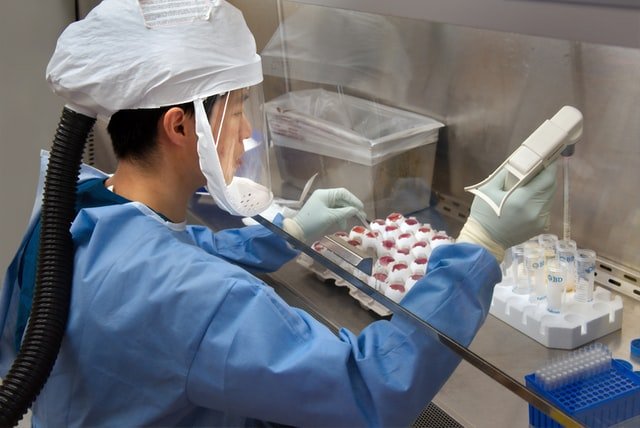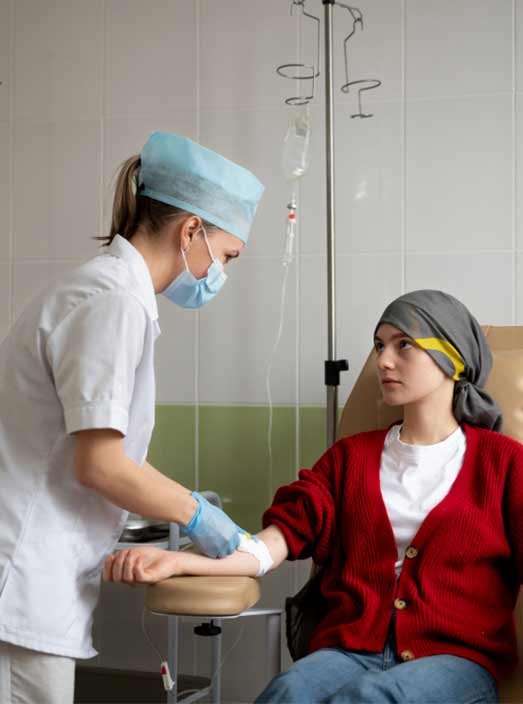Pancreatic Cancer
- Biotexus
- August 6, 2025
About the pancreas
The pancreas is a pear-shaped gland located in the centre of the abdomen between the stomach and the spine. It is made up of two primary parts.
The exocrine component consists of ducts and tiny sacs called acini at the duct ends. This section of the pancreas produces specific proteins known as enzymes, which are released into the small intestine to assist the body in digesting and breaking down food, particularly lipids.
The endocrine component is made up of cells called islets of Langerhans that are clustered together in various locations throughout the pancreas. These cells produce a variety of hormones, the most significant of which being insulin. Insulin is a hormone that regulates the quantity of sugar in the blood. Other hormones produced by this region of the pancreas include glucagon, somatostatin, pancreatic polypeptide (PP), and vasoactive intestinal peptide (VIP). Each of these hormones is crucial in controlling the body’s metabolism.
Types of pancreatic cancer
There are many forms of pancreatic cancer, based on whether the disease started in the exocrine or endocrine component.
Exocrine tumors : The most frequent kind of pancreatic cancer. This form of cancer is commonly referred to as pancreatic cancer. Adenocarcinoma is the most frequent kind of exocrine malignancy. These tumors, known as ductal adenocarcinoma, generally begin in the pancreatic ducts. Acinar adenocarcinoma is a far less frequent kind of tumor that starts in the acini.
Intraductal papillary mucinous neoplasm is an increasingly prevalent diagnosis (IPMN). An IPMN is a tumor that forms within the pancreatic ducts and produces a thick fluid called mucin.
Endocrine tumors : These are also known as pancreatic neuroendocrine tumors (PNETs) or islet cell tumors. They are far less prevalent than exocrine tumors, accounting for just around 7% of all pancreatic malignancies. This tumor is not the same as what most people think of as pancreatic cancer. A pancreatic neuroendocrine tumor might be active or inactive. A healthy tumor produces hormones. A tumor that is not functioning produces no hormones. The hormone that the cells ordinarily produce is used to identify a functional neuroendocrine tumor.
These include:
- Insulinoma
- Glucagonoma
- Gastrinoma
- Somatostatinoma
- VIPomas
- PPomas
Risk Factors
In general, the following factors may increase the risk of developing pancreatic cancer:
Age : The risk of developing pancreatic cancer increases with age. Most people who develop pancreatic cancer are over 45 years old. In fact, 90% are over 55 and 70% are over 65. However, adults of all ages can be diagnosed with pancreatic cancer and are rare in children.
Gender : Men develop pancreatic cancer more than women. Smoking. People who smoke are two to three times more likely to develop pancreatic cancer than those who do not smoke.
Obesity, diet and alcohol : Regular intake of high-fat foods is a risk factor for pancreatic cancer. Studies have shown that even obese and overweight people are at increased risk of being diagnosed with pancreatic cancer and dying. Chronic heavy drinking can also increase the risk of pancreatic cancer, probably by causing recurrent pancreatitis, recurrent inflammation of the pancreas.
Diabetes : Many studies have shown that diabetes increases the risk of developing pancreatic cancer, especially if a person has had diabetes for many years. In addition, late-onset adult-onset diabetes, sometimes referred to as new-onset diabetes, may be an early symptom of pancreatic cancer. However, it is important to remember that not all people who have diabetes or who have been diagnosed with diabetes as adults develop pancreatic cancer.
Family history : Pancreatic cancer can occur in the family and / or may be associated with a genetic condition that increases the risk of other types of cancer. This is called familial pancreatic cancer. If two or more first-degree relatives or at least three family members have been diagnosed with pancreatic cancer, you and your family may be at a higher risk. Parents, children, and siblings are examples of first-degree relations.
Symptoms
People with pancreatic cancer may experience the following symptoms. As the cancer grows, symptoms may include:
- Yellow skin (including yellowing of the gums and inner lips) and/or eyes, darkening of the urine, itching, and clay-colored stool, which are signs of jaundice caused by a blockage of the bile ducts
- Pain in the upper abdomen, upper back, or arms
- Painful swelling of an arm or leg due to a blood clot
- Burning feeling in the stomach or other gastrointestinal discomforts
- Stomach bloating
- Floating stools with a particularly bad odor and an unusual color due to the body not digesting fats well
- Weakness
- Loss of appetite
- Nausea and vomiting
- Chills and sweats
- Fever
- Unexplained weight loss
Treatment
Pancreatic cancer has a far better chance of being effectively treated if found early. However, for individuals with advanced pancreatic cancer, there are medicines that can help manage the illness and allow them to live longer and more comfortably. The common types of treatments used for pancreatic cancer are described below:
Surgery
Surgery for pancreatic cancer includes removing all or part of the pancreas, depending on the location and size of the tumor in the pancreas. An area of healthy tissue around the tumor is also often removed. This is called a margin. A goal of surgery is to have “clear margins” or “negative margins,” which means that there are no cancer cells in the edges of the healthy tissue removed.
Laparoscopy. The surgeon may opt to begin with a laparoscopy. Several small holes are created in the abdomen during a laparoscopy, and a tiny camera is inserted into the body while the patient is sedated. During this procedure, the surgeon will be able to determine whether the cancer has spread to other sections of the abdomen.
Surgery to remove the tumor. Depending on where the tumor lies in the pancreas, several forms of surgery are employed. All of the operations outlined here include the removal of adjacent lymph nodes.
Whipple technique : This procedure is also known as a pancreaticoduodenectomy. If the cancer is just in the head of the pancreas, a Whipple surgery may be performed. The pancreatic head and a section of the small intestine called the duodenum, as well as the bile duct and stomach, or occasionally just a portion of the stomach, are removed during this major surgery. The surgeon will next reattach the digestive tract and biliary system. Temporary drains are typically placed in the belly to aid in drainage and patient recovery.
Distal pancreatectomy : If the malignancy is found on the left side of the pancreas’ tail, this procedure is usually performed. The pancreatic tail and body, as well as the spleen, are removed during this procedure.
Total pancreatectomy : If the cancer has progressed throughout the pancreas or is found in many locations, a complete pancreatectomy may be required. The entire pancreas, a section of the small intestine, a portion of the stomach, the common bile duct, the gallbladder, and the spleen are removed during a complete pancreatectomy.
Radiation therapy
The use of high-energy x-rays or other particles to eliminate cancer cells is known as radiation therapy. Radiation treatment can be administered in a variety of methods, including:
Traditional radiation therapy : This is also known as standard fraction radiation therapy or conventional fraction radiation therapy. It consists of regular treatments of reduced radiation doses per fraction or day. It is typically administered over the course of 5 to 6 weeks, with weekends off from treatment.
Stereotactic body radiation (SBRT) or cyberknife : These are shorter treatments of greater doses of radiation therapy that can be completed in as little as 5 days. This is a newer form of radiation therapy that can deliver more targeted treatment in fewer sessions.
Treatment using proton beams : This is an external-beam radiation treatment technique that use protons rather than x-rays. Protons with great energy can damage cancer cells. It also reduces the quantity of radiation that reaches healthy tissue. Proton beam treatment can be administered for a set period of time or for a shorter period of time, similar to SBRT.
Therapies using medication
Medication-based treatments are used to kill cancer cells. Medication can be delivered through the circulation to cancer cells all throughout the body. Systemic treatment refers to the administration of a medicine in this manner. Medication can also be administered locally, which means that it is delivered directly to the malignancy or is retained in a certain portion of the body.
Chemotherapy
Chemotherapy is the use of medications to eradicate cancer cells, often by preventing cancer cells from growing, dividing, and proliferating. For pancreatic cancer, chemotherapy may be described by when and how it is given:
First-line chemotherapy : This is usually the initial treatment given to those who have either locally advanced or metastatic pancreatic cancer and have not previously received treatment.
Second-line chemotherapy is used : When the first therapy fails or ceases to suppress cancer development, the cancer is referred to be “refractory.” Primary resistance occurs when first-line therapy does not function at all. Treatment may sometimes function effectively for a period and then cease working, which is known as secondary or acquired resistance. If the patient’s general health is good, he or she may benefit from extra therapy with other medications.
Off-label application : This occurs when a medicine is prescribed for a problem that is not stated on the label.
Targeted therapy
Targeted therapy is a type of cancer treatment that targets specific genes, proteins, or the tissue environment that contributes to cancer development and survival. This sort of therapy inhibits cancer cell development and spread while protecting healthy cells.
Not all cancers have the same targets. Your doctor may suggest tests to determine the genes, proteins, and other variables in your tumor in order to discover the most effective treatment.



















